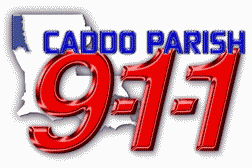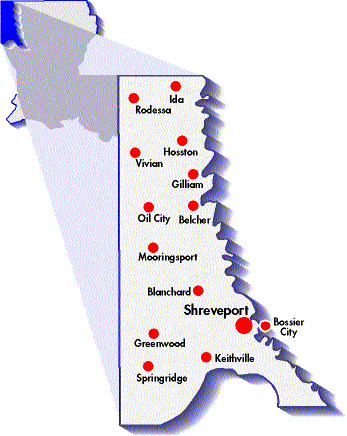
History of
Caddo Parish
Communications
District

| History of |
Caddo Parish is located in the far Northwest corner
of Louisiana approximately 185 miles due east of Dallas. The total population of the
parish is 252,161 (2000 Census), and the parish covers approximately 852 square
miles. On April 5, 1986, the voters of
Caddo Parish approved the assessment of a telephone surcharge to fund the development,
implementation and operation of an enhanced emergency telephone reporting system, 9-1-1.
The Caddo Parish Communications District was created by Parish Ordinance, and this
ordinance allowed for the creation of an appointed seven-member citizen board to establish
policies and to provide oversight to the 9-1-1 system and to the 9-1-1 staff. The proceeds from the telephone
surcharge fees are used to fund: the emergency telephone system/network; the emergency
communications equipment and equipment maintenance; employee training; eight 9-1-1
administrative staff positions; a communications facility to house all of the
agencies’ communications officers, who answer 9-1-1 calls and dispatch emergency
services personnel; and building/grounds maintenance. In 1988, construction was completed
on the first Emergency Communications Center (ECC) which is located at 1144 Texas Avenue
in Shreveport, Louisiana. This facility had approximately 9,900 square feet. During the
original design of the ECC in 1986-87, it was planned that all three public safety
agencies would be co-located in one facility: The Shreveport Police and Fire
Communications Divisions and the Caddo Parish Sheriff’s Communications operations as
well. However, in late 1987, it was decided that an alternate back up PSAP (Public Safety
Answering Point) would be constructed within the Courthouse. As a result the ECC design
was altered to exclude the Sheriff’s Operations, however, space was allocated for
future growth and the possibility of additional equipment and staff. In addition to the
public safety communications personnel, the ECC also houses the 9-1-1
Administrative Staff. The facility also serves as an Emergency Operations Center for
use by the Caddo/Bossier Office of Emergency Preparedness to be activated during a natural
disaster or major emergency. On September 17, 1989, the Caddo
Parish 9-1-1 emergency reporting system was implemented. The average monthly call volume
was 9,000 calls. Today, the system averages 22,000 calls per month. In 1991, the Caddo Parish 9-1-1
District negotiated intergovernmental agreements with the various public safety agencies
to centralize the call receipt of all 9-1-1 calls in the parish, to be routed to the ECC
with the Shreveport Fire Department serving as the initial call taker for all of the calls
and providing caller interrogation and station alerting functions for the nine rural fire
districts in the parish. In June 1992, the Caddo Parish Sheriff’s Department
re-located its communications operations into the ECC, which resulted in the physical
addition of four console positions into the communications operations area of the ECC. The
operations area has grown to 28 console positions with 124 communications personnel, who
make up the Communications Divisions of the Shreveport Fire Department, Shreveport Police
Department and Caddo Parish Sheriff's Office. After the 9-1-1 system was
implemented in 1989, the 9-1-1 Board continued to evaluate its operations and methods by
which the overall delivery of public safety services to the citizens of the Parish via the
Enhanced 9-1-1 system could be improved. In late 1990, the Board of Commissioners
established a System Enhancement Sub-committee to evaluate the existing communications
systems and determine if these systems would be sufficient to meet the future and
ever-increasing demands for services. The 9-1-1 Board, to solicit input to determine
communications needs and priority of projects, formed a technical sub-committee comprised
of representatives from each of the public safety agencies. For many months the Board of
Commissioners examined ways 9-1-1 could serve as a catalyst to improve the emergency
communications throughout the parish. On February 18, 1992, the Board voted to contract
with RCC/OMNICOM, Inc., a radio-consulting firm to
determine what type of radio system could best serve all of the public safety agencies in
the parish. After interviews with all of the public safety agencies in the parish and
reviewing the existing communications networks and associated problems, RCC/OMNICOM, Inc. presented the Board with several
system design alternatives and configurations. On December 8, 1992, the Board unanimously
adopted the System Enhancement Sub-committee’s recommendation to proceed with the
design for a multi-site 800 MHz 15-channel Simulcast Trunked Radio System. The projected
cost for this system was $15 million. Due to the lack of adequate funding to implement
this system in its entirety (parishwide), the Board adopted the System Enhancement
Sub-committee’s other recommendation to move forward with the development of another
much needed communications enhancement: a parishwide Computer-Aided-Dispatch (CAD) System.
In June, 1994, RCC/OMNICOM, Inc., presented a
comprehensive parishwide plan for the implementation for a CAD/Records Management System
that would allow migration to Mobile Data Computers and an Automatic Vehicle Location
System. Because of the impact that these
new communications systems would have on the existing ECC facility, the Board appointed a
Spatial Needs Sub-committee to review: the proposed equipment’s spatial requirements;
any existing building deficiencies; future staffing needs for all of the agencies in the
ECC; mechanical/HVAC systems’ capabilities; evaluation of existing space utilization;
structural evaluation and review of fire alarms/security systems. As a result, the Board
voted to commission the services of an architectural firm to provide direction to the
Board in its efforts to expand the communications systems and plan for future growth to
meet the needs well into the year 2010. The firm of Ralph Kiper & Associates was
chosed by the Board after the review of eight (8) written proposals and three (3) oral
presentations provided by local architectural firms. In November, 1996, construction
began on the $2.5 million facility expansion project. 9-1-1 District reserve funds
were used to fund this capital outlay project. The expansion project included adding
approximately 9,000 square feet to the existing 9-1-1 facility. The addition consists of a
new communications operations area for the public safety agencies with administrative
offices and a new communications equipment room. On February 26, 1998, the communications
operations for each of the agencies were moved into the new communications center. The
facility expansion also included remodeling the old communications center, incorporating a
training center and a stress mitigation room. In June, 1996, the District began
contract negotiations with Intergraph Public Safety
Corporation after an extensive Request for Proposals evaluation process for a new
Computer Assisted Dispatch (CAD) system and Records Management System (RMS). The District
executed an agreement with Intergraph in December, 1996.
One of the goals of the new CAD system was to automate all of the rural fire districts,
which provide fire/EMS services to the rural areas of the parish, as well as the Caddo
Parish Sheriff’s Office and the Shreveport Police and Fire Communications Divisions.
The primary functions of the new CAD system are: to more efficiently and effectively
facilitate the response to emergency calls for service through the 9-1-1 emergency
reporting telephone system, determine the location of the emergency, dispatch the
appropriate law enforcement/fire /EMS units and maintain a status of units assigned and
available to be assigned. The primary benefits of the new CAD system are: increased speed,
accuracy and reliability of the dispatch process; thus reducing response times; increased
safety by improving information available to field units; improved utilization and
management of law enforcement, fire fighting and emergency medical services by providing
more accurate and timely information about incidents and by improved status keeping and
display; will collect data concerning calls for service and subsequent responses in
support of management information for resource and departmental activity. The new CAD
system is graphics-based and will be utilizing the new digitized base-map of Caddo Parish
with longitude and latitude, guaranteeing accuracy within 2 and 1/2 feet. The new CAD
system is a client/ server-based system on a Windows NT operating system with dual
processors for redundancy for total system reliability. The total cost of the system was
$2,519,362. This project was funded through utilizing $1.5 million in existing operating
reserves and by issuing $1 million in Certifications of Indebtedness. The system became
operational on December 15, 1998. In an effort to secure the
necessary funding for the critically needed radio system, the Caddo Parish Communications
District introduced legislation during the 1996 Special Session of the Louisiana
Legislature, that would allow the 9-1-1 District to amend its existing enabling
legislation. This legislation would allow the Caddo 9-1-1 District to increase the 9-1-1
surcharge fee upon voter approval and to assess cellular and other wireless or future
technology that could access 9-1-1 service. This legislation became effective on June 19,
1996. On September 21, 1996, the voters
of Caddo Parish overwhelmingly approved an increase in the 9-1-1 surcharge fee, which will
enable the funding of the parishwide 800 MHz trunked radio system for all of the public
safety agencies in Caddo Parish. In June 1997, the District’s
radio engineers developed a comprehensive Statement of Work for the installation and
implementation of a seven (7) site 15-channel 800 MHz Simulcast Trunked Radio System. As a
result, the District executed an agreement with Motorola
in December 1997, pending funding approval from the State Bond Commission. The contract
with Motorola for the implementation of this new
system was divided into two (2) phases. Phase I
of the project involved the construction of four (4) new radio
communications tower, which are strategically located throughout the parish, the
installation of the repeaters and microwave system that will comprise the radio
infrastructure or backbone of the system. The cost of Phase I was approximately $6,715,392.
Phase
II of the project was the purchase and installation of the mobile and portable
radio equipment for the field personnel for each of the public safety agencies and will
cost an estimated $4,532,367. Total cost for Phases I & II was approximately
$11,247,759. On October 15, 2001, the new 800 MHz
15-channel simulcast trunked radio system went on-line. The new radio system enables
all public safety agencies in Caddo Parish to communicate more
efficiently and effectively by sharing one common radio network and totally compatible
radio equipment and frequencies. Prior to October 2001 Caddo Parish public safety agencies
operated independently and utilized different radio frequencies. As a result of this
individuality, during times of natural disasters or major emergencies, public safety
personnel could not easily communicate with each other during critical situations. To further
complicate this problem, these Caddo Parish agencies could not communicate with Bossier City
Police and Fire Departments, the Bossier Parish Sheriff or the Louisiana State Police. The
Bossier agencies and the Louisiana State Police were operating on Motorola trunked radio
systems and were not compatible with the old systems in Caddo. This inability to
communicate with adjacent jurisdictions and within the parish during natural disasters or
coordinated law enforcement activities resulted in the lack of coordination,
uniformity and unity. The new 800 MHz system insures total interoperability with the State
Police, Bossier Parish Sheriff, Bossier City Police and Fire Departments. The District
utilized existing operating reserves of $1.5 million and the proceeds from the issuance of
Certificates of Indebtedness to fund the respective phases of the project.
![]()
![]()
In an effort to provide the public safety agencies in the parish affordable, reliable and accurate paging, the District contracted with Motorola, Inc., for the purchase of a parish-wide alpha-numeric paging system, which utilizes the District's radio towers. The paging system is a stand-alone, non-commercial system and cost approximately $330,000. The paging system became operational on July 30, 2000 and supports over 475 pagers.
For a better overview of each of the communications systems enhancements, please visit our Technology Update page.
History of Caddo 9-1-1 | Emergency? Now What? | Caddo Parish 9-1-1 Facts
Tips When Calling 9-1-1 | Meeting Minutes
How to Get an Address | 9-1-1 Call Statistics | Job Opportunities
9-1-1 Staff & Board | Caddo Public Safety | Public Safety Links
Telephone Service Provider Surcharge Information | Home